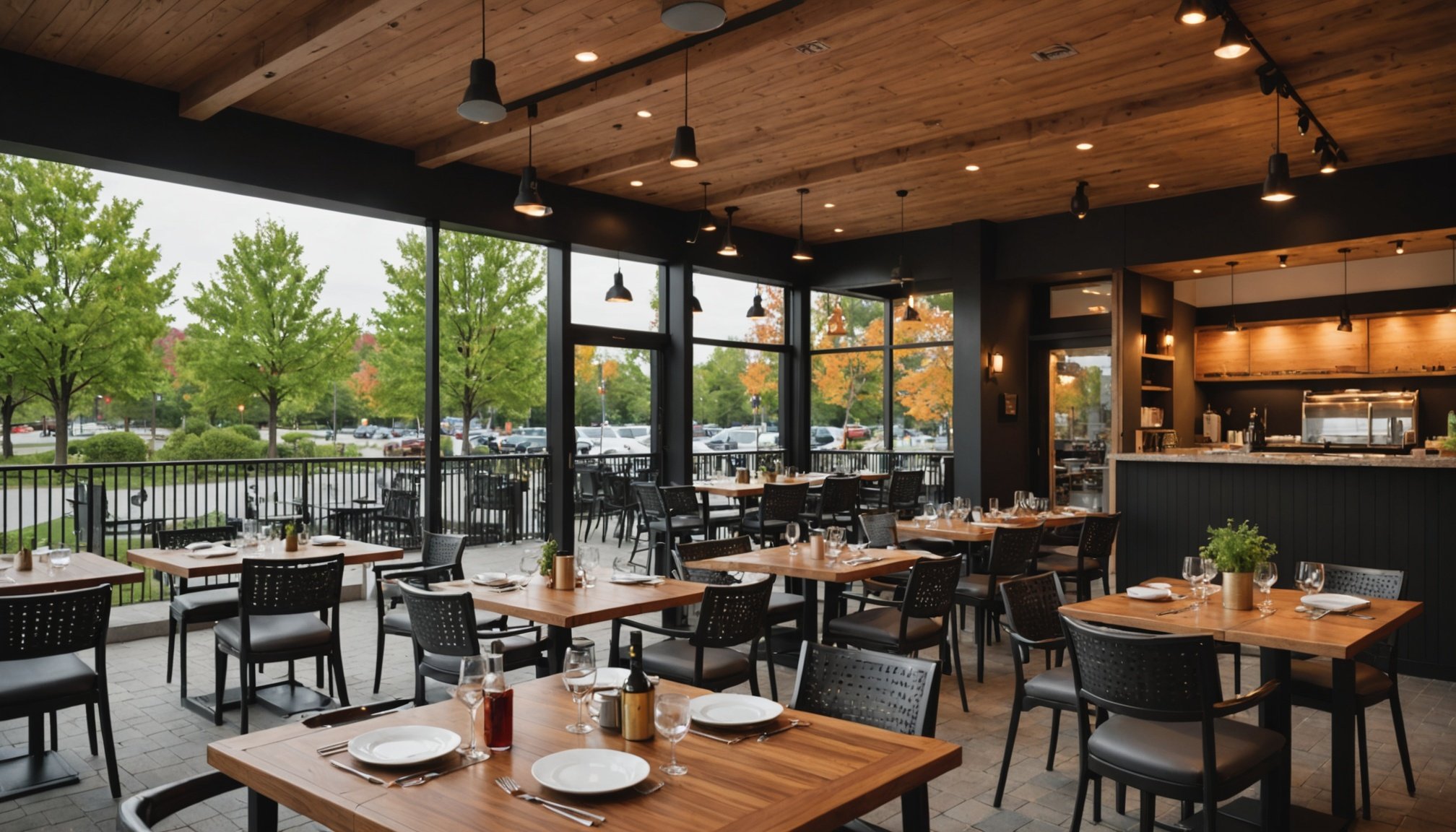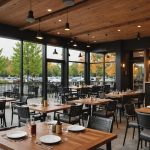Importance of Outdoor Dining Spaces
Creating appealing outdoor dining spaces offers substantial benefits, enhancing both restaurant appeal and the overall customer experience. In the aftermath of the pandemic, there has been a noticeable shift towards outdoor dining, with patrons preferring open-air experiences for both safety and enjoyment. This trend increases customer satisfaction, contributing significantly to increased foot traffic.
Outdoor dining can greatly transform a restaurant’s ambiance and aesthetic, aligning with emerging consumer preferences for alfresco experiences. Patrons value the sense of freedom and relaxation provided by these spaces. Moreover, outdoor areas allow restaurants to expand their seating capacity without extensive structural changes, effectively enhancing their customer experience and catering to diverse groups.
Topic to read : Elevating dining experience: harnessing customer insights for restaurant menu improvement
Furthermore, outdoor spaces play a crucial role in a restaurant’s branding strategy. Such zones allow for creative expression, reflecting and enhancing the restaurant’s identity. Elements such as unique decor, themed designs, and innovative use of space can differentiate businesses in a competitive market. This strategic use of outdoor areas fosters a memorable dining experience synonymous with the brand’s ethos.
By embracing the outdoor dining trend, restaurants are positioning themselves advantageously within the hospitality sector, tapping into consumer desires for engaging, safe, and appealing dining environments.
Topic to read : Building a sustainable tomorrow: innovative approaches for bars to source eco-friendly spirits and wines
Innovative Design Concepts for Outdoor Dining
When crafting outdoor dining design, blending aesthetics with functionality is key to creating a memorable experience. Incorporating natural elements such as plants and greenery enhances ambiance, offering a refreshing touch. These features not only beautify the space but can also create natural privacy screens and sound barriers.
Utilizing Natural Elements
Adding water features, like fountains or small ponds, serves as a focal point and infuses tranquillity into the restaurant spaces. The gentle sound of water complements dining, enriching the sensory experience.
Unique Seating Arrangements
Diverse seating options can accommodate various group sizes, from intimate pairs to larger gatherings. Consider using a mix of benches, individual chairs, and communal tables. Flexible layouts are crucial, promoting social interactions while allowing for easy reconfiguration based on customer needs.
Themed Decor Strategies
A consistent theme helps reinforce the restaurant’s identity. Opt for decorative elements that align with your brand, creating a cohesive atmosphere. Additionally, seasonal decor changes keep the dining experience dynamic and enticing for returning customers. This strategy not only enhances the aesthetic appeal but also maintains customer interest and excitement over time.
Practical Tips for Functionality
Efficient outdoor dining functionality is vital for enhancing the flow and comfort of your space. To optimise customer flow, consider designing clear pathways that guide patrons effortlessly around diverse seating arrangements. This not only aids in navigating the area but also contributes to a more pleasant dining experience.
Accessibility is another critical aspect. Ensure that your outdoor space accommodates all patrons, including those with disabilities. This might involve installing ramps or choosing furniture that balances style with accessibility, promoting inclusivity.
Managing space effectively during peak times can be challenging yet rewarding. Look at these strategies to maximise efficiency:
-
Flexible Seating Configurations: Employ modular furniture that can be rearranged to suit different group sizes, ensuring you cater to both small gatherings and larger parties.
-
Booking Systems: Implement thoughtful reservation systems to manage capacity and reduce wait times.
Adopting these measures not only improves efficiency but significantly enhances the customer experience. By paying attention to these functional aspects, you can ensure a seamless dining flow that accentuates your restaurant’s appeal. This approach benefits both the restaurant and guests, fostering a welcoming and enjoyable atmosphere for everyone.
Effective Lighting Solutions
Lighting plays a crucial role in enhancing outdoor dining experiences, influencing ambiance and restaurant appeal.
Layered Lighting Techniques
Implementing a layered approach involves using ambient, task, and accent lighting strategically across different areas. Ambient lighting, like soft overhead fixtures, sets a calming tone, while task lighting, such as focused lamps, supports practical needs. Accent lighting highlights specific features, adding character and depth to the dining environment. Embracing smart lighting technologies can introduce dynamism, adjusting brightness and colours to suit different occasions and enhance the overall atmosphere.
Seasonal Lighting Adjustments
Adapt lighting designs according to seasonal changes to maintain inviting spaces year-round. For instance, warmer hues during colder months and cooler tones in summer can harmonise with natural light variations. Additionally, energy-efficient solutions, like LED lights, ensure reduced electricity costs while upholding environmental standards. These adjustments go beyond aesthetics, playing a vital role in sustaining comfortable and attractive outdoor dining environments regardless of the season.
Incorporating diverse lighting techniques not only augments the customer experience but also solidifies the eatery’s identity within the hospitality landscape. With thoughtful lighting designs, restaurants can entice more patrons and enhance their outdoor spaces creatively, leading to increased foot traffic and customer satisfaction.
Weather Protection Strategies
Creating comfortable outdoor dining spaces requires effective strategies to manage weather conditions. Integrating both fixed and movable structures can significantly enhance dining comfort and ensure usage during varied weather. Awnings and pergolas are excellent options; they not only provide shelter from rain and sun but also add to the aesthetic appeal of the space.
Heat lamps and fans are versatile tools that heighten comfort across climates. In cooler months, heat lamps offer warmth, allowing guests to enjoy the outdoor ambiance without discomfort. Conversely, during warmer seasons, fans help circulate air, providing a refreshing breeze.
Incorporating outdoor heaters and misters also plays a pivotal role in maintaining an enjoyable dining experience. Heaters extend the usability of outdoor spaces into cooler evenings, making them inviting for guests in various seasons. Likewise, misters effectively combat heat spikes, delivering fine cooling mist to increase guest satisfaction.
Such weather protection measures not only align with the trend towards alfresco dining post-pandemic but also reinforce a restaurant’s appeal by adapting to customer preferences all year round. Employing these solutions ensures that outdoor spaces are inviting and functional, safeguarding the customer experience regardless of the elements.
Sustainable Materials and Practices
Aligning with a growing trend towards sustainability in dining, restaurants increasingly incorporate eco-friendly strategies. By choosing sustainable furniture made from recycled and environmentally conscious materials, eateries can underline their commitment to the planet. This not only conserves resources but also enhances the dining space with durable, stylish elements that naturally age gracefully.
Choosing Sustainable Furniture
Opting for furniture crafted from materials such as bamboo or recycled metals benefits both the environment and the restaurant’s branding. These long-lasting materials support an eco-friendly ethos, providing a unique selling point for environmentally conscious clientele. Since these materials require less maintenance and are resistant to weather changes, they are ideal for outdoor settings.
Implementing Eco-Friendly Practices
Incorporating robust waste management solutions is vital for efficiently handling leftovers and recyclable materials in outdoor dining areas. Moreover, partnering with local producers for ingredients ensures fresh, quality dishes and reduces the carbon footprint related to transportation. Utilising these sustainable practices not only supports environmental goals but also aligns the restaurant with consumer preferences for eco-friendly dining experiences. By demonstrating responsible practices, restaurants foster a loyal customer base, valuing both their meals and their environmental impact.
Customer Engagement Strategies
Enhancing customer engagement within outdoor dining requires innovative strategies. Creating memorable experiences through interactive events not only attracts patrons but also encourages them to return. For example, hosting themed evenings in the alfresco space, such as cultural nights or seasonal celebrations, can provide guests with a dynamic and entertaining atmosphere.
Interactive Experiences
Integrating experiential dining elements, like cooking classes or interactive tastings, transforms the outdoor area into more than just a dining spot. These activities allow guests to engage with the menu and culinary techniques, providing a deeper connection to the restaurant’s offerings. By fostering a sense of participation, restaurants can elevate the overall dining experience.
Promotions and Loyalty Programs
Special incentives such as discounts, exclusive deals, or seasonal promotions can effectively boost the appeal of outdoor dining promotions. Additionally, implementing loyalty programs that reward frequent visitors nurtures long-term relationships. By offering unique outdoor experiences as part of these programs, restaurants can differentiate themselves within a competitive market, enhancing both engagement and customer satisfaction.
Focusing on these strategies not only improves patron interaction but also strengthens a restaurant’s reputation, making outdoor dining an integral and competitive element of the overall business model.
Case Studies of Successful Transformations
Exploring real-life examples of successful restaurants provides insights into effective outdoor dining transformations. These restaurant case studies highlight the power of strategic integration within outdoor dining spaces, showcasing tangible gains in restaurant appeal and customer engagement.
One standout example involves a coastal eatery that revitalised its outdoor area by incorporating sea-themed elements. This transformation not only enhanced its ambiance but also clearly resonated with locals and tourists, boosting foot traffic dramatically. Local materials were employed to construct rustic, weather-resistant furniture, aligning with the venue’s eco-conscious branding. As a result, revenue during peak season rose significantly due to increased customer experience satisfaction.
Another notable case features an urban bistro that adapted its alleyway into a thriving alfresco dining area. By introducing vertical gardens and overhead string lights, the restaurant crafted a cosy, inviting atmosphere that drew evening crowds. Strategic promotions, like themed musical nights, encouraged repeat visits and membership in loyalty programs. This creative use of space not only enhanced the establishment’s visibility but also strengthened its connection with the local community, illustrating the impact of targeted outdoor dining improvements on profitability.
Importance of Outdoor Dining Spaces
Outdoor dining has significantly reshaped the customer experience, enticing diners with its unique charm. Post-pandemic, there’s been an evident shift towards outdoor dining, driven by a preference for open-air settings that blend safety with enjoyment. This trend aligns perfectly with customer desires, enhancing overall satisfaction and helping to attract increased foot traffic.
Restaurants capitalise on outdoor spaces to boost their restaurant appeal. These zones not only transform the ambiance but also expand seating capacity economically without drastic structural changes. The blend of open-air dining with creative setups gives patrons a sense of freedom, relaxation, and delight. Furthermore, embracing this trend allows restaurants to tap into a larger market, catering to varied preferences and demographics.
In addition, outdoor dining plays a pivotal role in a restaurant’s branding strategy. Designing these spaces with a strategic vision can reflect and amplify the restaurant’s identity. When curated with uniqueness and character, these areas differentiate businesses in a competitive landscape. From unique decor to thematic designs, effective use of outdoor spaces becomes synonymous with the brand’s ethos, fostering memorable experiences that resonate with patrons long after their visit.











